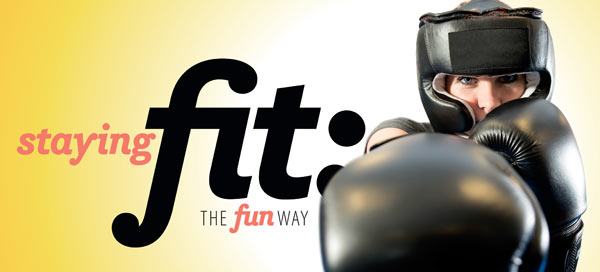
The start of a new year inspires such good intentions. Exercise tops the list for many who actually make resolutions.
But somewhere around the second or third week of January—if you make it that far—it’s easy to get off track. You skip the gym visit after work or burrow back under the covers for another half hour of sleep instead of getting up early to walk.
Maybe what you need isn’t stronger resolve, but an alternative fitness option… something that doesn’t feel so much like “exercise.”
Good news! You can get a great workout and burn calories without setting foot in a gym. If traditional exercise just isn’t your style, we’ve researched different alternatives to get you moving—and having fun at the same time.
The Department of Health and Human Services recommends that healthy adults get at least 150 minutes of moderate exercise or 75 minutes of vigorous exercise each week, as well as at least two sessions of strength training exercises weekly.
(Author’s note: In this article, the calories burned per activity are calculated on a 150-pound person. You’ll burn more (or less) depending on how much you weigh. See sidebar to learn more.)
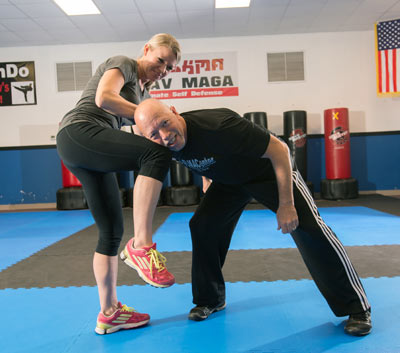
Krav Maga
It may sound like a video game, but it’s actually a self-defense system that offers the additional advantage of building fitness and stamina.
“It’s a great way to increase your fitness level from top to bottom, head to toe; plus, you’re learning something practical,” says Barbara Bruno, instructor and co-owner, together with husband Guy, of Florida Martial Arts & Fitness, which has two locations in Ocala. “Krav Maga is never boring because it’s non-repetitive and you’re interacting with other people of like mind who want to learn self defense but also get fit.
“You burn more calories doing Krav Maga than in a traditional martial arts class because of the drills,” she adds. “The class opens with high-intensity cardio work; everyone leaves hot, sweaty and drenched!”
Both Brunos know all about fitness. The husband-wife duo are both certified fitness trainers, and Guy is a seventh degree black belt, while Barbara is a sixth degree black belt. They’ve owned Florida Martial Arts & Fitness in Ocala since 2004.
Krav Maga was designed for the Israeli Defense Forces to help men and women protect themselves in all situations. The unique thing about the system is that it works for people at all different ages and fitness levels. You’ll get an excellent workout as you learn to master combative moves such as kicking and punching, plus self-defense techniques like how to slip out of a choke or bear hug. Whether or not you ever need to use these techniques to protect yourself in the real world, the physical benefits are what attract many participants.
“Krav Maga has been around since the 1930s, but it’s really taken off in the United States in the last 10 years,” says Barbara. “We’ve been teaching it here in Ocala for the past two years.”
Don’t worry; you don’t need previous martial arts experience. The best way to get started is to sign up for an intro lesson, during which you’ll learn a little history behind Krav Maga and get to practice some of the key moves. Following the 30-minute intro class is a Krav Maga level 1 class, which lasts 50 minutes. (Mention this article and you’ll get your first class for free!)
Krav Maga classes are held twice weekly and take place in the evening. You don’t need special gear; just wear comfortable workout clothes and sneakers.
Although there are five levels to Krav Maga, you only have to move up through the levels if you choose.
“Classes are on-going, and you can continue at the same level as long as you want,” Barbara explains. “If you want to add intensity and a new dimension, you can move up by levels.”
Some participants opt to stay for the Krav Fit classes, which follow each Krav Maga class. These half-hour sessions are built around circuit training and are all about strengthening and cardio work.
“We coach you so you’re not on your own,” says Barbara. “You have five-minute rounds for 30 seconds each at 10 stations. It’s all about ‘go hard, go fast.’ It’s intense but fun. About half the students stay for this. It just depends on how much time they can commit.”
Although martial arts attract many young students, Krav Maga was designed for adults.
“We have a lot of professional people taking the classes and people at every level of fitness,” Barbara notes. “You don’t have to be afraid to sign up if you’re not in shape. You push as hard as you can at your own level of fitness. We had one student who lost nearly 70 pounds in one year doing Krav Maga.”
Florida Martial Arts & Fitness(352) 861-5425 / flmacenter.com
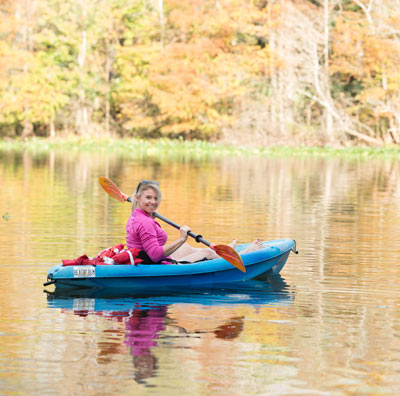
Kayaking
Kayaking certainly qualifies as exercise that doesn’t really feel like exercise. You’re in a boat, cruising along under your own power and taking in the scenic surroundings of natural Florida. What’s not to like?
“You can get quite a bit of fitness—even though it’s relaxing—just because of the constant paddling,” says Ryan Toler, owner of Discovery Kayak Tours, a full-service guide and kayak tour company, which also rents kayaks at Silver Springs State Park. Toler, a Florida native who’s lived in Ocala since 1987, is a kayak guide, instructor and naturalist.
“Both arms are engaged, and if you’re paddling correctly, you’re twisting and using your core. If you’re going for fitness, not just sightseeing, you’re going to be more aggressive about paddling, but kayaking can also be as relaxing as you want it to be,” adds Toler, who has college degrees in both environmental science and outdoor education.
“A lot of people think a kayak looks more scary than a canoe because it’s smaller, but don’t be intimidated,” he says. “So many people tell me, ‘I’ll never canoe again’ after they try a kayak. It’s very easy for most people to get in and go. What we’re trying to do with classes is teach proper technique for safety reasons but also so you can be more efficient and enjoy your experience. I’ve had people in their 70s and 80s paddle for three and four hours because they’ve learned the proper techniques.”
Those who have canoed in the past generally find kayaking to be easier overall. You have a more comfortable sitting position and a more efficient paddling motion.
Unlike some other forms of exercise, kayaking appeals to many participants because it gets you into nature, often in very remote areas that can’t be accessed except by water. You’ll have the opportunity to see the “real” Florida, including wildlife… often up close and personal.
If you’ve never tried kayaking before, your best bet is to take a class first. Ryan teaches an introductory two-hour class and provides all the equipment; just dress comfortably (layers are best because you will warm up paddling) and wear water shoes or sports sandals that can get wet.
You’ll learn the proper way to get in and out, how to launch, stroke techniques, safety and more. You’ll also learn how to incorporate a brief stretching session before you get in the kayak to loosen your hamstrings and lower back and help prevent soreness.
Once you’ve experienced a kayak outing, you’ll probably be hooked. But don’t worry—you don’t need to spend big bucks to participate regularly. You don’t even have to buy your own boat.
Ryan regularly operates tours in at least a dozen different locations and, depending on the season, plans several tours per week. Most participants don’t own a kayak or any equipment and prefer to rent.
If you do have your own kayak, there are paddle clubs across the state so you can explore new places while reveling in the fact that you’re staying fit at the same time.
Discovery Kayak Tours (352) 789-4959 / discoverykayaktours.com
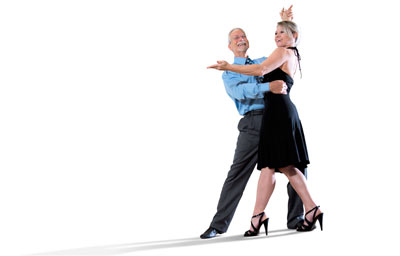
Dancing
Who knew an hour on the dance floor could be such a fun way to burn calories?
“Ballroom dancing has been proven to improve cardiovascular and bone health. Getting your heart rate moving can also lead to lower blood pressure and lower cholesterol,” says John Whipple, champion dance professional, instructor and owner of Dancin’ Around Studio in Ocala, which he opened in 1992.
“When you’re starting out, the beginner steps aren’t that challenging, but as you stick with it, the moves get more intricate. By that time you’ve built up stamina, mobility and balance,” he adds. “I get a lot of professionals who tell me dancing takes their minds off everything else because you have to focus on it, and that reduces stress.”
Not to worry if ballroom isn’t your thing. Whipple also teaches Latin, country and three types of swing: East Coast, West Coast and hustle.
Interest in specific styles of dance changes with the times.
“There will always be some people who hang onto certain styles of dance, but everything comes in trends, whether it’s fashion or dance,” notes Whipple, who taught country swing at area nightspots in the 1980s. “There’s less interest in country here locally. We’re in an elegant period now with more waltz, foxtrot and tango. Salsa was really hot a few years ago here but not so much now.”
Not sure what style you’ll like? Whipple regularly teaches “sampler” classes, which include three styles of dance over a six-week period.
“You don’t know what you like until you try it. When anyone is undecided, I recommend they take a sampler class. You get to try different styles, and it gets you on the dance floor having fun,” he says, adding that music is a strong influence as to what style a person will enjoy.
“If you sign up for salsa, but don’t like Latin music, that probably won’t work for you. If you like 50s music, you probably need to be in a swing class.”
You can also sign up for private lessons, but many people prefer the group lessons. These 50-minute evening classes are held on Mondays, Tuesdays and Thursdays. Classes meet on the same night at the same time for six weeks. There’s even a party at the end of the session so you can practice what you’ve learned.
You don’t even need a partner to attend. Whipple finds students learn faster when they rotate dance partners.
Whipple sees everyone from doctors and firefighters to professionals to soccer moms in his classes. Participants range in age from teens and college students to retirees. If you’ve never done much dancing, sign up for a level 1 class, which is specifically designed for those with little to no dance experience.
And no, you don’t have to dress like a Dancing with the Stars contestant. Just wear comfortable attire and footwear that conforms well to your foot but without sticky rubber soles. For women, that means flats or low heels; for men, dress shoes are ideal. Leave the hiking boots, sandals and flip-flops at home.
Whipple emphasizes that while dancing is a great aid to fitness, it’s also much more.
“Dancing also has a social component that other activities don’t have,” he says. “You share camaraderie, make new friends and there’s lots of laughing. It helps people become more confident and have a higher quality of life. I hear on a daily basis from people about how they were reluctant at first but now like dancing so much, and that’s so rewarding to me as a teacher.”
Dancin’ Around Studio (352) 690-6637 / danceocala.com
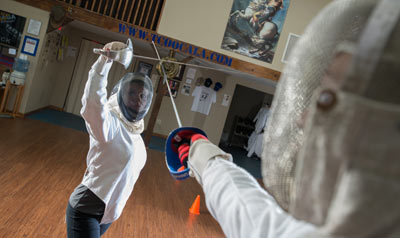
Fencing
Forget the choreographed fencing scenes you’ve watched in movies. Real fencing is an Olympic sport that requires complete mental and physical strategy and skill.
Fencers often refer to their sport as “physical chess” because it fully engages the mind as well as the body. Fencing offers a mind-body connection, and you don’t need impressive physical strength to succeed. In fact, the physical requirements aren’t hard on the body, which is why you’ll find fencers still enjoying the activity throughout their lives.
“Probably 50 percent of fencing is mental. You don’t realize how much exercise you’re getting because you’re so focused,” says Phillip Vincent, 33, who opened En Garde Fencing Club in downtown Ocala at the beginning of 2013.
A professional coach and the club’s instructor, Phillip has been fencing since age 14 and competed in varsity fencing throughout his college years at The Wharton School at the University of Pennsylvania where he led the men’s team to two Ivy League Championships. A member of the United States Fencing Association, Phillip has competed nationally and internationally. He also teaches in The Villages at the Lifelong Learning College.
If you’re looking to improve your cardiovascular system, develop and strengthen muscles, become more flexible, increase your stamina and work on your fine motor skills, fencing may be exactly the activity you’re looking for. (Plus, there’s something a bit daredevil about exercising with sword in hand!)
However, no true fencer calls his or her weapon a “sword.”
“Just like a policeman refers to his gun as a weapon or a ‘piece,’ we refer to ours as a ‘weapon,’” Phillip explains, adding that fencers actually have three different types of weapons:
Foil: Used for thrusting only; target area is the opponent’s vest, both front and back
Epee: Also a thrusting weapon; target area includes the entire body
Sabre: Used for thrusting and slashing; target area is from the waist up
A true fencing “bout” is three minutes long. The first opponent to score five touches is the winner.
Despite the fact that weapons are involved, Phillip emphasizes that fencing is not a violent activity and full contact isn’t allowed. You’re wearing protection on both your head and body, and the lightest touch of the blade registers a point, so you don’t need to strike hard.
You’ll learn the moves slowly and practice slowly and then build up to speed as you gain skill and confidence. As you develop rhythm, timing and focus, you’ll be surprised what a complete workout you’re getting.
Basic gear (mask, jacket, glove, weapon and bag) runs about $175, but you don’t have to make a commitment right away.
“Most people take classes for a month or two before deciding to buy their own gear,” says Phillip, who teaches adult classes in the evenings and on Saturday afternoons. “You can take an intro class to see if you’re interested. It’s just $20, and all the gear you need is provided for the class.”
“Anyone can do fencing. You don’t have to be the biggest, strongest or fastest person; you have to be the smartest,” says Phillip. “As you become older, you also become smarter. That means it can be a life-long sport.”
En Garde Fencing Club LLC (352) 286-9608 / engardefencingclub.com
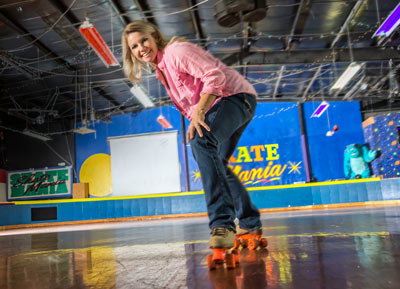
Roller-skating
Remember how much fun you had roller-skating as a kid? Well, it’s still fun, but it’s also an excellent form of exercise.
A University of Massachusetts study found that roller-skating has 50 percent less impact on joints than running. Not only does it provide a low-impact workout, it also offers a cardiovascular workout equivalent to that of running when skating at 10mph or faster. Plus, the faster you skate, the more calories you burn.
“It’s also good for working your core and lower body muscles,” says Jason Merrick, manager and instructor at Skate Mania in Ocala, an indoor roller rink where the original maple wood floor is the second largest in the Southeast. “You can spend a couple hours skating, and it’s a great workout, but it doesn’t feel like going to the gym and slaving away. A lot of people come in to skate for exercise, and we have seniors coming because their doctors have recommended skating for its cardio benefits.”
Another benefit is that skating improves coordination and balance… both helpful as one ages.
Even if you haven’t skated in decades—or ever—you can start slowly and skate at your own pace as you build endurance and strength. Even slow skating will give your cardiovascular system and muscles a workout.
“We have quite a few regulars at our public sessions,” says Merrick. “It’s a great way to get the kids involved, have some fun and get exercise as a family, but we also have adult nights on Mondays.”
You can always take a few lessons if you’ve never skated before or want to learn proper technique.
“We have a beginner skating program on Saturday mornings for all ages, and starting in February, DeeDee Denney, whose daughter, Caydee, hopes to compete in the Olympics is coming on board as a coach,” says Merrick. “DeeDee will be teaching the beginner program and also private lessons in figure skating.”
You can choose between traditional quad skates or inline skates, often referred to as rollerblades. Merrick says most people just use the rink’s skates (skate rental is included with admission), but some bring their own. He says a decent pair of basic skates starts at $50 to $60.
And of course, if you have your own skates, your options increase when you find paved outdoor areas for skating.
Skate Mania (352) 624-4222/ skatemania.org
Skate-A-Way South (352) 671-8100 / facebook.com/skateawaysouth






